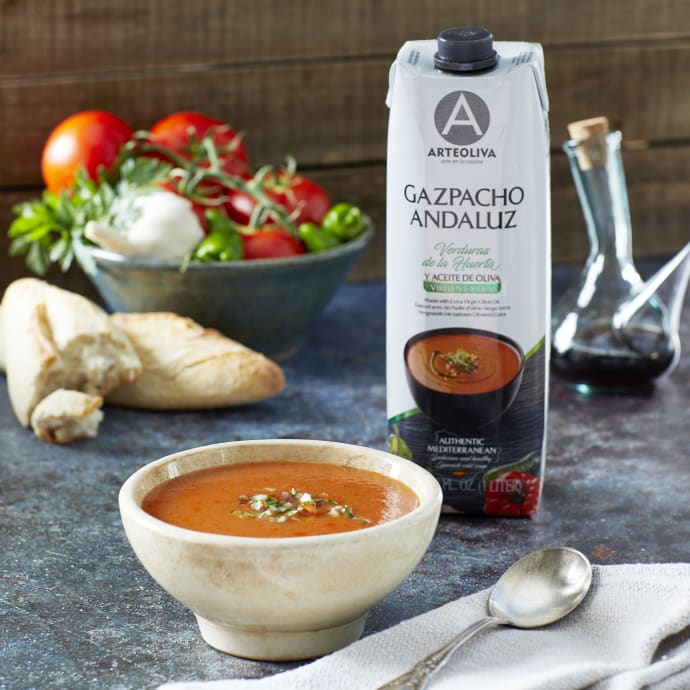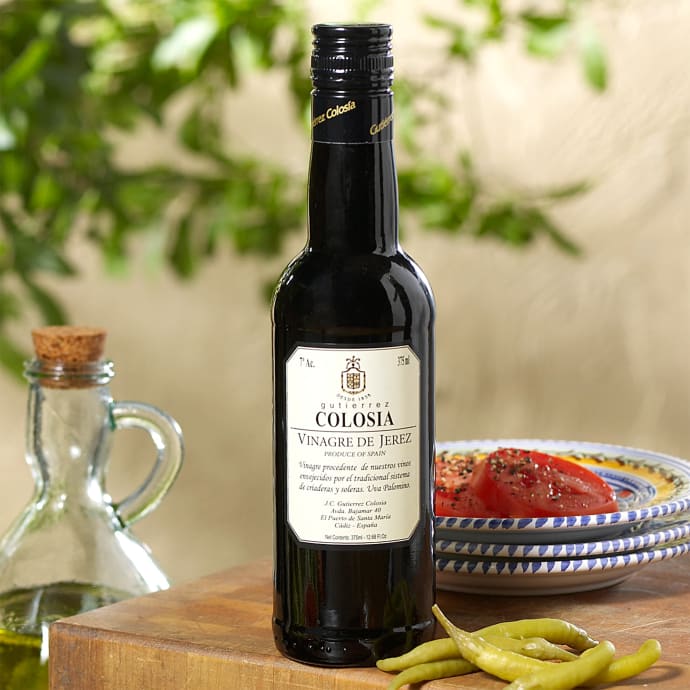
Salad in a Glass
Gourmet Magazine
-
July 1, 2002
Penelope Casas
Gazpacho was born in the fields of southern Spain, and there my most vivid memories of gazpacho go back to an August afternoon in Cordoba some 30 years ago. My husband, Luis, and I had made the acquaintance of Feliciano Delgado, Augustinian priest and professor at the University of Cordoba, who graciously offered to show us the city's awesome 10th-century mosque. Afterward, he invited us his 17th-century house in the city's Old Quarter. The afternoon sun was fiery and the temperatures wilting, but the whitewashed patio, filled with antiques and shaded by a colorful awning, was cool and tranquil. Feliciano's elderly mother brought us earthenware tumblers of gazpacho, the "liquid salad" that is the quintessence of the laid-back Andalusian lifestyle. We felt welcomed, relaxed, and revived, and it was then that I truly understood gazpacho's unique relevance to Andalusia's scorching climate.
Gazpacho -- the word comes either from Hebrew gazaz or the pre-Roman caspa, both meaning "fragments" and referring to gazpacho's bread base -- began as poor people's food. Prepared by Andalusian field workers at lunchtime under the shade of an olive or oak tree, it consisted of nothing more than leftover bread, crude olive oil, vinegar, garlic and water. But it made a satisfying, relatively nourishing meal that required no cooking and no utensils other than a mortar and pestle. Over the centuries each region of Andalusia developed its own distinctive version of gazpacho, each based upon these few simple ingredients.
The discovery of the New World introduced Spain to tomatoes and peppers, both native to the Americas, and transformed gazpacho. Then in the 19th century, Eugenia de Montijo, empress of France and Andalusian by birth, made the foods of her homeland fashionable throughout the French Empire; gazpacho was no longer "food for reapers and vulgar people," as defined in a 17th-century Spanish dictionary.
Today, a precise definition of the dish is difficult to come by, but there are certain widely accepted parameters. Traditional gazpacho fall into two basic categories: red and white. Green gazpacho, which may contain peppers, spinach, and cilantro, are rare, and hot gazpacho is another oddity. Spanish chefs generally frown on the idea of putting cucumber and onion in gazpacho, and they also go light on garlic and green pepper. The little bowls of finely chopped garnishes -- something of a tourist cliche -- are foreign to true gazpacho lovers, who often prefer drinking their gazpacho. "Gazpacho is really a beverage" declares Paco Nunez de Prado, owner of the company that makes Nunez de Prado olive oil. "That's how I have always known it." I have to agree -- in summer there is always a jar of gazpacho in my refrigerator, and I pour it by the glass whenever thirst overcomes me.
Although I consider myself well versed in gazpacho, last summer Luis and I set off to delve into the finer points of the tradition. Driving 300 miles through the summer heat of Andalusia, we sampled amazing varieties of gazpachos.
We began in Cadiz, an ancient city nearly surrounded by water, tenuously attached to the mainland by a narrow isthmus. Restaurants in Cadiz take great pride in their gazpachos, leading to friendly rivalries like the long-standing rift between Gonzalo Cordoba, of El Faro restaurant, and Salvador Lucero, chef-owner of Bar Bahia. For many years I have been a fan of Salvador's gazpacho, but I am equally impressed by Gonzalo's exquisitely refined version, incorporating elegant and subtly fruity hojiblanca extra-virgin olive oil from the province of Cordoba and aged Sherry vinegar produced in nearby Jerez de la Frontera.
The city of Rhonda, in Malaga province, was our next gazpacho stop. At upscale Tragabuches restaurant, we found some fascinating renditions -- gazpacho with goose barnacles and licorice, gazpacho with shrimp-filled ravioli and herring roe, and (easily my favorite) sorbet of gazpacho on a bed of apple gelee, sprinkled with a reduction of balsamic vinegar and topped with salt-cured tuna called mojama. To our dismay, however, we also discovered that even it its homeland gazpacho can sometimes be perfectly dreadful. At one generally well regarded restaurant in Ronda we found that gazpacho was watery and tasteless. (From Ronda, fittingly, comes a tale of disgruntled field workers who complained to their foreman, Manuel, of low wages and pathetically small lunches. He, in turn, relayed their grievances to the landowner, who declined to augment their paychecks but agreed to increase their food rations. "Manuel," he commanded, "starting tomorrow, add more water to the gazpacho.")
In the city of Malaga, ajo blanco, a creamy white gazpacho made with blanched ground almonds, is the local star. It's sweet-sour contrast -- vinegar vying with tidbits of melon, grapes, apple, or raisins -- hints at a Moorish salad in a glass.
Gazpacho was born in the fields of southern Spain, and there my most vivid memories of gazpacho go back to an August afternoon in Cordoba some 30 years ago. My husband, Luis, and I had made the acquaintance of Feliciano Delgado, Augustinian priest and professor at the University of Cordoba, who graciously offered to show us the city's awesome 10th-century mosque. Afterward, he invited us his 17th-century house in the city's Old Quarter. The afternoon sun was fiery and the temperatures wilting, but the whitewashed patio, filled with antiques and shaded by a colorful awning, was cool and tranquil. Feliciano's elderly mother brought us earthenware tumblers of gazpacho, the "liquid salad" that is the quintessence of the laid-back Andalusian lifestyle. We felt welcomed, relaxed, and revived, and it was then that I truly understood gazpacho's unique relevance to Andalusia's scorching climate.
Gazpacho -- the word comes either from Hebrew gazaz or the pre-Roman caspa, both meaning "fragments" and referring to gazpacho's bread base -- began as poor people's food. Prepared by Andalusian field workers at lunchtime under the shade of an olive or oak tree, it consisted of nothing more than leftover bread, crude olive oil, vinegar, garlic and water. But it made a satisfying, relatively nourishing meal that required no cooking and no utensils other than a mortar and pestle. Over the centuries each region of Andalusia developed its own distinctive version of gazpacho, each based upon these few simple ingredients.
The discovery of the New World introduced Spain to tomatoes and peppers, both native to the Americas, and transformed gazpacho. Then in the 19th century, Eugenia de Montijo, empress of France and Andalusian by birth, made the foods of her homeland fashionable throughout the French Empire; gazpacho was no longer "food for reapers and vulgar people," as defined in a 17th-century Spanish dictionary.
Today, a precise definition of the dish is difficult to come by, but there are certain widely accepted parameters. Traditional gazpacho fall into two basic categories: red and white. Green gazpacho, which may contain peppers, spinach, and cilantro, are rare, and hot gazpacho is another oddity. Spanish chefs generally frown on the idea of putting cucumber and onion in gazpacho, and they also go light on garlic and green pepper. The little bowls of finely chopped garnishes -- something of a tourist cliche -- are foreign to true gazpacho lovers, who often prefer drinking their gazpacho. "Gazpacho is really a beverage" declares Paco Nunez de Prado, owner of the company that makes Nunez de Prado olive oil. "That's how I have always known it." I have to agree -- in summer there is always a jar of gazpacho in my refrigerator, and I pour it by the glass whenever thirst overcomes me.
Although I consider myself well versed in gazpacho, last summer Luis and I set off to delve into the finer points of the tradition. Driving 300 miles through the summer heat of Andalusia, we sampled amazing varieties of gazpachos.
We began in Cadiz, an ancient city nearly surrounded by water, tenuously attached to the mainland by a narrow isthmus. Restaurants in Cadiz take great pride in their gazpachos, leading to friendly rivalries like the long-standing rift between Gonzalo Cordoba, of El Faro restaurant, and Salvador Lucero, chef-owner of Bar Bahia. For many years I have been a fan of Salvador's gazpacho, but I am equally impressed by Gonzalo's exquisitely refined version, incorporating elegant and subtly fruity hojiblanca extra-virgin olive oil from the province of Cordoba and aged Sherry vinegar produced in nearby Jerez de la Frontera.
The city of Rhonda, in Malaga province, was our next gazpacho stop. At upscale Tragabuches restaurant, we found some fascinating renditions -- gazpacho with goose barnacles and licorice, gazpacho with shrimp-filled ravioli and herring roe, and (easily my favorite) sorbet of gazpacho on a bed of apple gelee, sprinkled with a reduction of balsamic vinegar and topped with salt-cured tuna called mojama. To our dismay, however, we also discovered that even it its homeland gazpacho can sometimes be perfectly dreadful. At one generally well regarded restaurant in Ronda we found that gazpacho was watery and tasteless. (From Ronda, fittingly, comes a tale of disgruntled field workers who complained to their foreman, Manuel, of low wages and pathetically small lunches. He, in turn, relayed their grievances to the landowner, who declined to augment their paychecks but agreed to increase their food rations. "Manuel," he commanded, "starting tomorrow, add more water to the gazpacho.")
In the city of Malaga, ajo blanco, a creamy white gazpacho made with blanched ground almonds, is the local star. It's sweet-sour contrast -- vinegar vying with tidbits of melon, grapes, apple, or raisins -- hints at a Moorish salad in a glass.
Other Press
A trio of savory snacks to enjoy this fall
Atlanta Journal-Counstitution
-
November 1, 2024
The 15 Best Gifts for People Who Love Food
Wirecutter
-
October 23, 2024
This Classic Garlic Keeper Is the One Thing I Made Sure I Brought Back from Spain
The Kitchn
-
July 10, 2024
That's How the Light Gets In
Defense Visual Information Distribution Service
-
April 20, 2024


